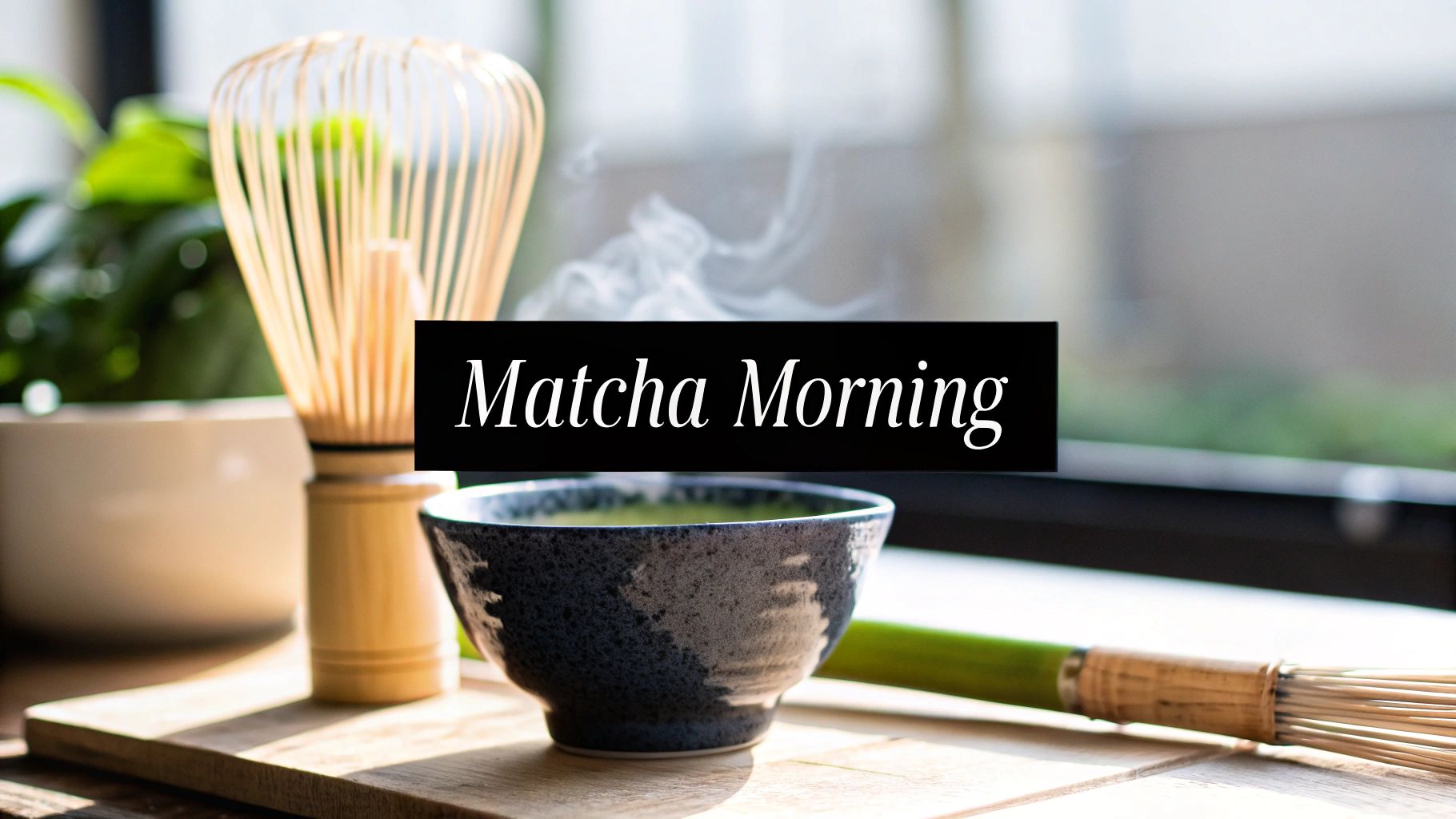So, you're wondering whether to have your morning matcha before or after breakfast. The short answer is: it really depends on you. Drinking matcha on an empty stomach can be a brilliant way to kickstart your focus and metabolism, but for some people, it can cause a bit of digestive upset.
Let's break down whether this popular ritual is the right fit for your body and how choosing a premium blend, like Amatsu Matcha, can make all the difference.
The Quick Answer to Morning Matcha
The choice to drink matcha before you've eaten anything really comes down to your own sensitivity. Many people find it gives them a clean, clear-headed energy boost, but others might feel it's a little too much without some food to act as a buffer.
What's going on here? It’s all about how quickly your body absorbs the natural compounds in matcha when your stomach is empty.
To really get it, you need to know what's in that vibrant green cup.
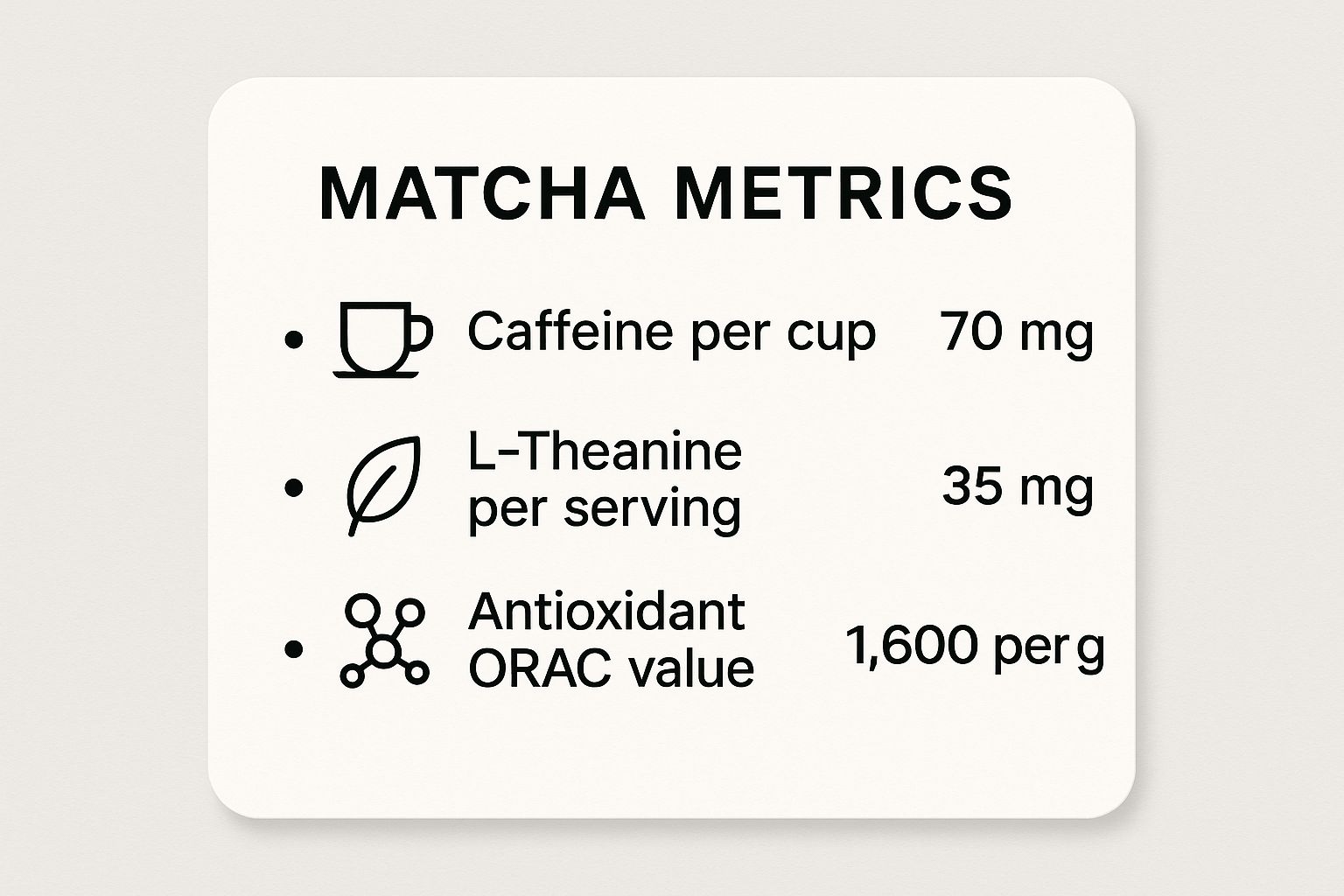
It’s this special mix of caffeine for alertness, L-theanine for a sense of calm focus, and powerful antioxidants that makes matcha such a unique experience.
Pros and Cons at a Glance
So, what are the immediate trade-offs of having matcha first thing? Before we get into the nitty-gritty science, this quick summary will help you weigh up the benefits against the potential downsides.
If you want the full picture, you can explore the complete range of matcha health benefits in our in-depth guide.
Think of it like this: an empty stomach is like an express lane for all the good stuff in matcha. You'll feel the positive effects much faster, but you're also more exposed to potential irritation if your system is a bit sensitive.
Here's a simple comparison table to help you decide what's best for you.
Matcha on an Empty Stomach Pros vs Cons
This table gives a straightforward look at the good and the not-so-good when it comes to sipping matcha before food.
| Potential Benefit | Potential Drawback |
|---|---|
| Faster Absorption of caffeine and L-theanine gives you a quicker mental lift. | Increased Stomach Acid from tannins might cause some mild discomfort. |
| Enhanced Metabolism as your body gets a gentle nudge first thing in the morning. | Potential Nausea can happen if you're sensitive to caffeine without food. |
| Maximised Antioxidant Uptake because there's no food to get in the way. | Jittery Feelings are possible if you're particularly sensitive to stimulants. |
Ultimately, the best way to know is to listen to your body. Starting with a smaller amount of high-quality matcha or having it alongside a light snack can be a great way to ease into it.
How Your Body Responds to Morning Matcha
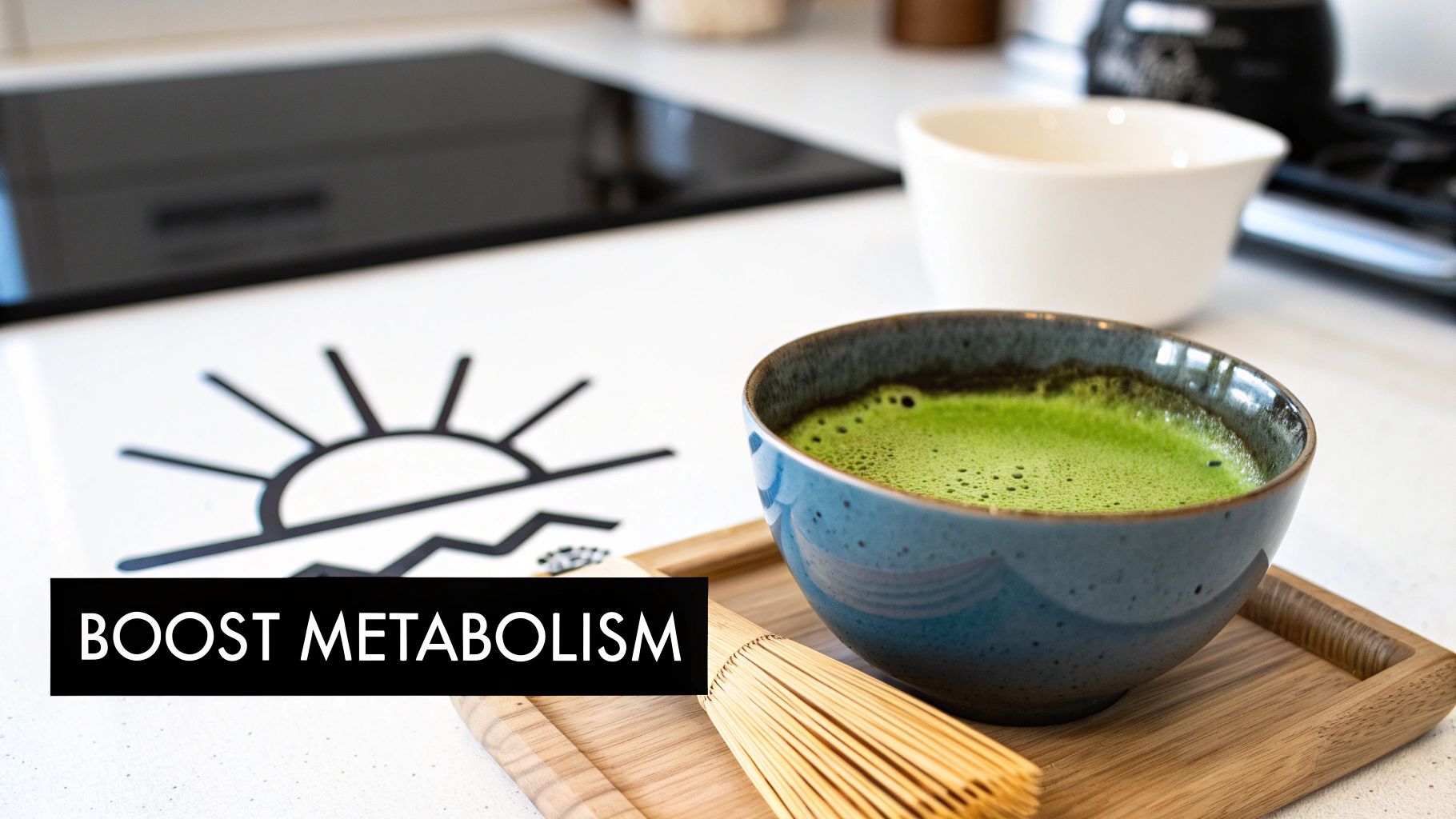
Imagine your stomach first thing in the morning is like a dry sponge, ready to soak up whatever you introduce to it. When you drink matcha on an empty stomach, its potent compounds are absorbed almost instantly into your bloodstream, with no food to slow down the process.
This is precisely why you feel that characteristic ‘calm-alert’ state so quickly. The two star players, caffeine and L-theanine, get to work right away, delivering a clean and steady wave of focused energy.
Of course, this rapid absorption isn't just for the good stuff. Matcha also contains natural plant compounds known as tannins.
The Role of Tannins and Stomach Acid
When these tannins hit an empty stomach, they can sometimes encourage the production of more gastric acid. This acid is normally there to help digest food, but without a meal to work on, it can occasionally irritate the stomach lining.
This is the main reason why a few people might experience a bit of nausea or slight discomfort. It's not a sign that matcha is "bad" for you, but simply a natural physiological reaction when there’s no food to act as a buffer.
Ultimately, your own sensitivity to tannins and caffeine will determine how you feel.
The experience is highly individual. While one person might feel energised and clear-headed, another might find it slightly too intense without a small snack. Listening to your body is the most important step.
Knowing this simple science helps you make the best choice for your own morning ritual.
Caffeine Absorption Without a Buffer
Just like the tannins, the caffeine in matcha also gets a fast pass into your system. This means you’ll feel a more immediate lift in energy compared to drinking it with or after a meal. For many of us, this is a huge plus, offering the mental clarity needed to kick-start the day.
What makes matcha’s caffeine so special is its partnership with L-theanine, an amino acid that fosters a feeling of relaxation without making you sleepy. This beautiful synergy is what gives you that sustained, jitter-free focus. If you're interested in how it stacks up against other brews, you can dive deeper into the caffeine in matcha vs coffee in our detailed guide.
At the end of the day, having matcha before breakfast creates a more direct and powerful effect. By understanding how your body handles its key ingredients, you can decide whether this fast-tracked absorption is right for you, or if you’d rather ease into your day with a small bite first.
Why a Pre-Breakfast Matcha Ritual is a Game-Changer
For a growing number of us, that first drink of the day isn't coffee—it's matcha. Having it on an empty stomach has become a powerful morning habit, and for good reason. It’s more than just a warm, comforting drink; it’s a ritual that genuinely sets you up for the hours ahead, delivering a clean mental clarity and a sustained, gentle energy that coffee just can't seem to replicate.
What's the secret? It all comes down to the beautiful partnership between caffeine and an amino acid called L-theanine. This incredible compound encourages alpha brain waves, which are the same ones that pop up when you're in a state of relaxed alertness. It’s like tuning your mind to the perfect frequency for a productive day—calm, focused, and ready for whatever comes your way.
This is the perfect headspace for diving into a demanding workday or getting prepped for a solid session at the gym.
Kick-starting Your Focus and Metabolism
When you drink matcha before any food, you're giving your metabolism a gentle nudge to get going. With nothing else in your system, your body can absorb all of matcha’s powerful compounds more efficiently, letting its natural thermogenic properties get to work straight away. This can really support your body’s fat-burning processes throughout the day.
At the same time, you’re giving your system a direct hit of potent antioxidants. We're talking about catechins like EGCG (epigallocatechin gallate), which are famous for their ability to fight oxidative stress and keep your cells healthy.
Think of it like this: having matcha first thing gives your body an unfiltered, front-line defence of these protective compounds. You're basically putting up a shield against the day's environmental stresses before you've even properly started.
This isn't just a niche trend; people across the UK are catching on. The interest in matcha fits perfectly with a wider shift towards functional foods, with a recent survey showing 62% of global consumers are now actively looking for natural ways to boost their energy. And with matcha packing in around 137 times more antioxidants than regular brewed green tea, it's perfectly placed to deliver. If you're interested in the numbers, you can dive deeper into these trends in this detailed matcha market report.
Making Your Morning Ritual Your Own with Amatsu Matcha
The best part is that you can completely personalise your morning ritual to fit what you need that day. The specific matcha you choose can really elevate the experience and help you hit your goals.
- For Pure Mental Clarity: If you need to lock in and focus, a classic ceremonial blend like Amatsu Matcha 'Pure' is your best bet. It’s designed to deliver that signature calm-but-alert state, making it perfect for days that demand serious mental endurance.
- For Pre-Workout Power: Hitting the gym or going for a run? A blend like Amatsu Matcha 'Strength' is formulated with creatine to give your physical performance and energy levels a real boost, making it the ideal pre-breakfast drink on training days.
- For Inner Radiance: Want to support your skin from within? Amatsu Matcha 'Radiance' is infused with marine collagen to give your morning ritual a beauty-boosting edge.
- For Adaptogenic Support: Looking for balance and resilience? Amatsu Matcha 'Shrooms' contains functional mushrooms to support your cognitive function and help you adapt to daily stressors.
By choosing the right blend, your morning matcha stops being just a drink. It becomes a conscious first step towards a more focused, energised, and healthier day ahead.
Common Side Effects and How to Prevent Them
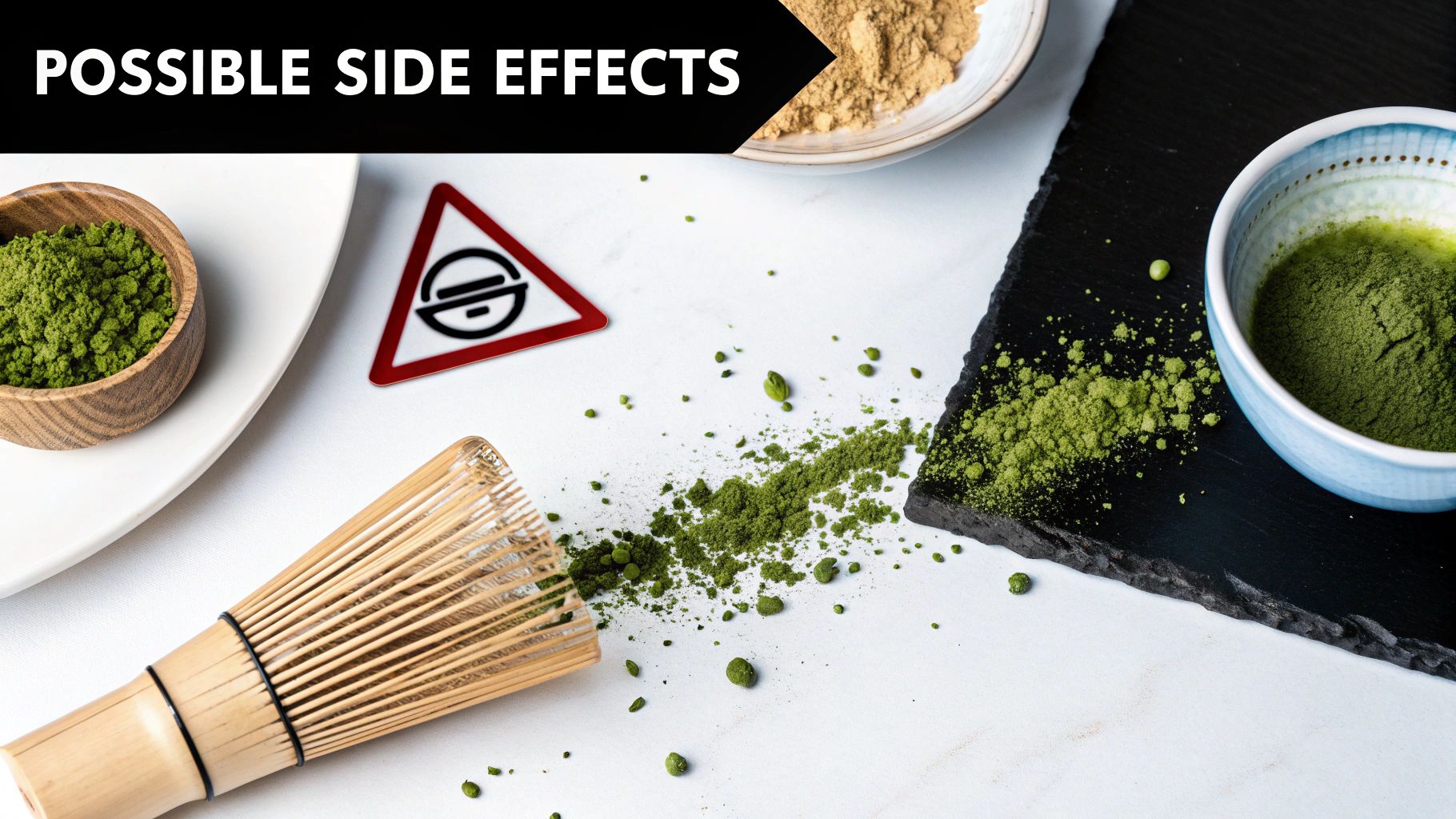
While the benefits of an empty-stomach matcha ritual are pretty compelling, it’s always wise to listen to your body when building a new habit. For some people, that first cup can sometimes cause a bit of an unsettled feeling or a sense of being 'over-caffeinated'.
The good news? These issues are almost always preventable. Think of them less as a problem and more as a little nudge from your body asking for a slight adjustment. With a few simple tweaks, you can easily fine-tune your routine for a smooth, enjoyable experience every single time.
Managing Stomach Sensitivity
The most common complaint is a touch of stomach irritation. This is usually down to the natural tannins in matcha, which can get your gastric acid production going. Without any food to act as a buffer, that can feel a little intense for some. Thankfully, the fix is usually quite simple.
First, just try a smaller serving. Instead of a full teaspoon of matcha, start with half. This simple adjustment immediately lowers the concentration of both tannins and caffeine, giving your stomach a much gentler introduction to your morning.
Another great trick is to have a small, light bite alongside your matcha.
- A handful of almonds: These provide protein and healthy fats that help to line the stomach.
- A few slices of apple: The fibre acts as a brilliant natural buffer.
- Half a banana: It’s soft, easy to digest, and packed with gentle nutrients.
A tiny snack like this won't cancel out the benefits you’re looking for, but it provides just enough of a cushion to head off any potential discomfort.
It's also worth remembering that the quality of your matcha makes a huge difference here. Higher-grade ceremonial matcha, like Amatsu's 'Pure' blend, is naturally smoother and less bitter. That's because it’s made from the youngest, most tender tea leaves, which contain fewer tannins to begin with.
Avoiding the 'Over-Caffeinated' Feeling
That slightly jittery, on-edge feeling is something else that caffeine-sensitive people might notice. Matcha is famous for its calm, sustained energy, but when your stomach is empty, the caffeine hits your system much faster.
The answer here is simply moderation. Pay attention to how you feel and begin with a smaller amount to gauge your personal response. If you know you're particularly sensitive, make sure you're well-hydrated with a glass of water before you even touch your matcha. This helps your system process everything that much more smoothly.
By understanding what is in matcha powder, you can really appreciate how its unique compounds work in harmony. A top-quality matcha has a beautifully balanced ratio of L-theanine to caffeine, which is what creates that signature calm alertness. Opting for a premium blend ensures you get the very best of this synergy, making any unwanted side effects far less likely.
How to Choose the Right Matcha for Your Mornings
Not all matcha is created equal, and this is never more true than when you’re drinking it on an empty stomach. The quality you choose can be the difference between a smooth, vibrant morning ritual and a bitter, unpleasant one. It all comes down to one key factor: the grade of the matcha powder.
You'll generally see two main categories: ceremonial and culinary grade. It helps to think of it like the difference between a fine wine meant for sipping and a cooking wine you’d splash into a stew. Both are great, but you wouldn’t get them mixed up.
Ceremonial vs Culinary Grade: A Clear Distinction
Ceremonial grade matcha is the gold standard for drinking. It’s crafted from the youngest, most tender tea leaves, which are then painstakingly stone-ground into a fine, brilliantly green powder. This grade is naturally sweet, almost creamy, and has very little bitterness. That’s because it’s low in tannins, making it the perfect choice for drinking straight, especially before you've eaten.
Culinary grade, on the other hand, is made from older, more mature leaves. This gives it a bolder, more astringent flavour and a less vibrant colour, which is why it holds its own so well in lattes, smoothies, and baking. That higher tannin content, however, makes it much more likely to irritate an empty stomach. For a deeper dive, you can explore our complete guide on how to find the best quality matcha.
Choosing a high-quality ceremonial grade matcha is the single best way to ensure a smooth and gentle experience on an empty stomach. The lower tannin level and finer texture are kinder to your digestive system, allowing you to enjoy all the benefits without the potential discomfort.
This distinction is more important than ever. Matcha’s popularity has exploded recently, and here in the UK, there was a reported 202% increase in matcha consumption by 2023, largely thanks to a growing wellness culture. This incredible surge in demand can sometimes lead to shortages, affecting the very ceremonial grades that are best suited for an empty stomach ritual. You can read more about the UK's growing demand for matcha on medino.com.
Find Your Perfect Amatsu Matcha Blend
To really make your morning count, you need a matcha that fits your personal wellness goals. At Amatsu Matcha, we’ve created a curated range of premium ceremonial blends, each designed to support a specific intention.
- Pure: For the traditionalist who wants an authentic start. This is our classic ceremonial grade, delivering that pure, focused energy and signature calm-alert feeling.
- Radiance: To nourish your body from the inside out. We've infused this blend with marine collagen to support skin health, adding a beauty boost to your morning.
- Shrooms: For a bit of adaptogenic balance. This blend features functional mushrooms like Lion's Mane and Cordyceps to support cognitive function and daily resilience.
- Strength: For some pre-workout power. Enriched with creatine, this one is designed to enhance physical performance and help with muscle recovery.
By picking the right Amatsu Matcha blend, you can turn your morning cup from a simple drink into a purposeful ritual that’s tailored just for you.
Simple Steps to Prepare the Perfect Cup of Matcha
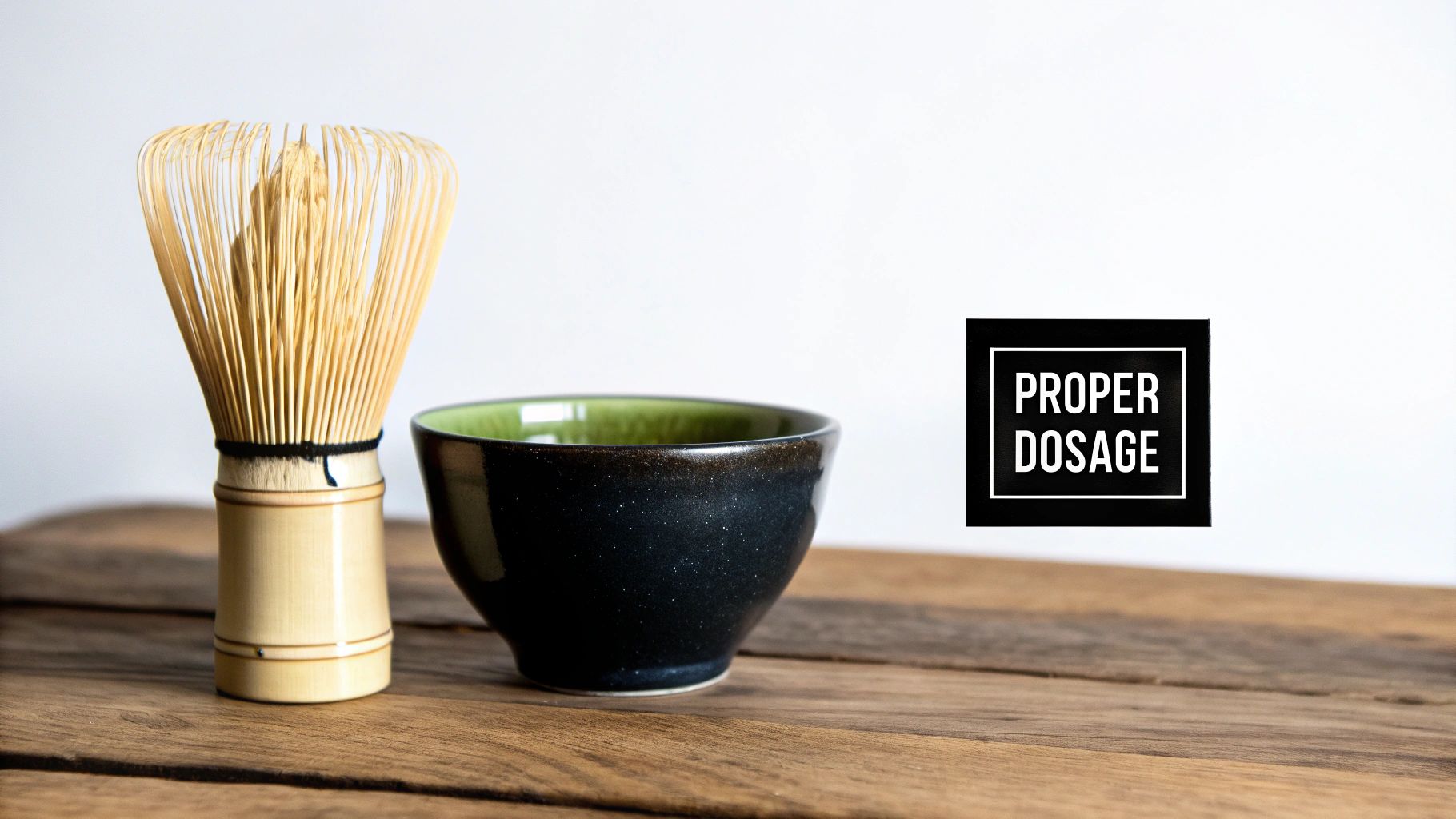
How you prepare your matcha is just as crucial as the quality of the powder, especially when you’re drinking it first thing on an empty stomach. A thoughtfully made cup isn't just about flavour; it's about making sure it's gentle on your system while unlocking all those incredible benefits.
Getting the preparation right turns a simple morning drink into a truly effective daily ritual. It’s not difficult, but paying attention to a few small details is what separates a bitter, lumpy brew from a perfectly smooth and frothy one.
Perfecting Your Preparation Technique
The first, and arguably most important, step is getting the water temperature right. Boiling water is the enemy of good matcha. It's far too aggressive for the delicate ground tea leaves and will scorch the powder, leaving you with a harsh, bitter taste. You’re aiming for water that’s hot but not boiling—around 80°C (175°F) is the sweet spot.
Next, and this is a step many people skip, you absolutely must sift your matcha powder. This simple action is the secret to preventing clumps and achieving that silky-smooth texture everyone loves. Just use a small, fine-mesh sieve to gently press the powder into your bowl, ensuring it will dissolve beautifully when you add the water.
Think of sifting like aerating flour for a cake. It breaks up any little clumps held together by static, allowing the water to mix in evenly and helping you create that signature creamy froth. Honestly, this step is non-negotiable if you want a premium experience.
When it comes to the ratio, a good starting point is about one to two grams (roughly half to one teaspoon) of matcha for every 60-80ml of hot water. Of course, you can always adjust this to suit your taste, whether you prefer a stronger or milder brew.
Finally, it's time to whisk. Whether you enjoy the mindful ritual of a traditional bamboo whisk (a ‘chasen’) or prefer the speed of an electric frother, the goal is the same. Whisk with purpose in a zig-zag 'W' or 'M' pattern until a delicate, fine foam blankets the surface.
For a more detailed walkthrough, you can check out our complete guide on how to prepare matcha perfectly every time. Following these simple tips will ensure your morning cup is always a pleasure.
Got Questions About Your Morning Matcha?
It's only natural to have a few questions when you're dialling in your morning routine. Matcha is a wonderful addition, but getting it just right can make all the difference. To help you perfect your own ritual, we’ve put together some straightforward answers to the most common queries we hear about drinking matcha on an empty stomach.
Let's clear up any confusion so you can sip with confidence.
How Long Should I Wait to Eat After My Matcha?
Timing is a big part of the magic here. As a general rule of thumb, it’s a good idea to wait about 20-30 minutes after finishing your matcha before you sit down for breakfast.
Giving it this little window allows your body to get the most out of all the good stuff – like the L-theanine and antioxidants – without food interfering with absorption. It also lets your stomach settle, paving the way for a comfortable first meal of the day.
Can I Drink Matcha on an Empty Stomach if I Have Acid Reflux?
If you struggle with acid reflux, it pays to be a little careful. While matcha is generally much kinder to the stomach than coffee, the natural tannins it contains can sometimes encourage the production of stomach acid.
My advice? Start small. Try a tiny serving of a high-quality ceremonial grade matcha, maybe just a quarter or half teaspoon, and see how you feel. It might also help to have a small, alkaline snack alongside it, like a few almonds or a piece of melon. The most important thing is to listen to your body; if you notice any discomfort, it's best to have your matcha after a light meal instead.
Your personal comfort is always the best guide. Starting small and pairing matcha with a light snack are simple ways to test the waters without missing out.
Is Matcha Better Before or After a Morning Workout?
This one really comes down to what you want to achieve with your workout. For a brilliant boost in energy, focus, and endurance, having your matcha about 30 minutes before you start is a fantastic strategy. The caffeine provides a steady, sustained release of energy that can power you through without the dreaded jitters.
Our Amatsu Matcha 'Strength' blend was created with exactly this in mind, fortified with creatine to really support performance and recovery. That said, enjoying a cup afterward is a great way to help your body relax and replenish itself with a dose of powerful antioxidants. Our Radiance blend with collagen is a perfect post-workout option to support recovery.
Ready to create a morning ritual that truly works for you? Discover the perfect blend for your goals with Amatsu Matcha. Whether you're after pure focus, a pre-workout lift, or a touch of inner radiance, our premium ceremonial matcha is crafted to elevate your daily wellness. Explore the full Amatsu Matcha collection today.
Read more
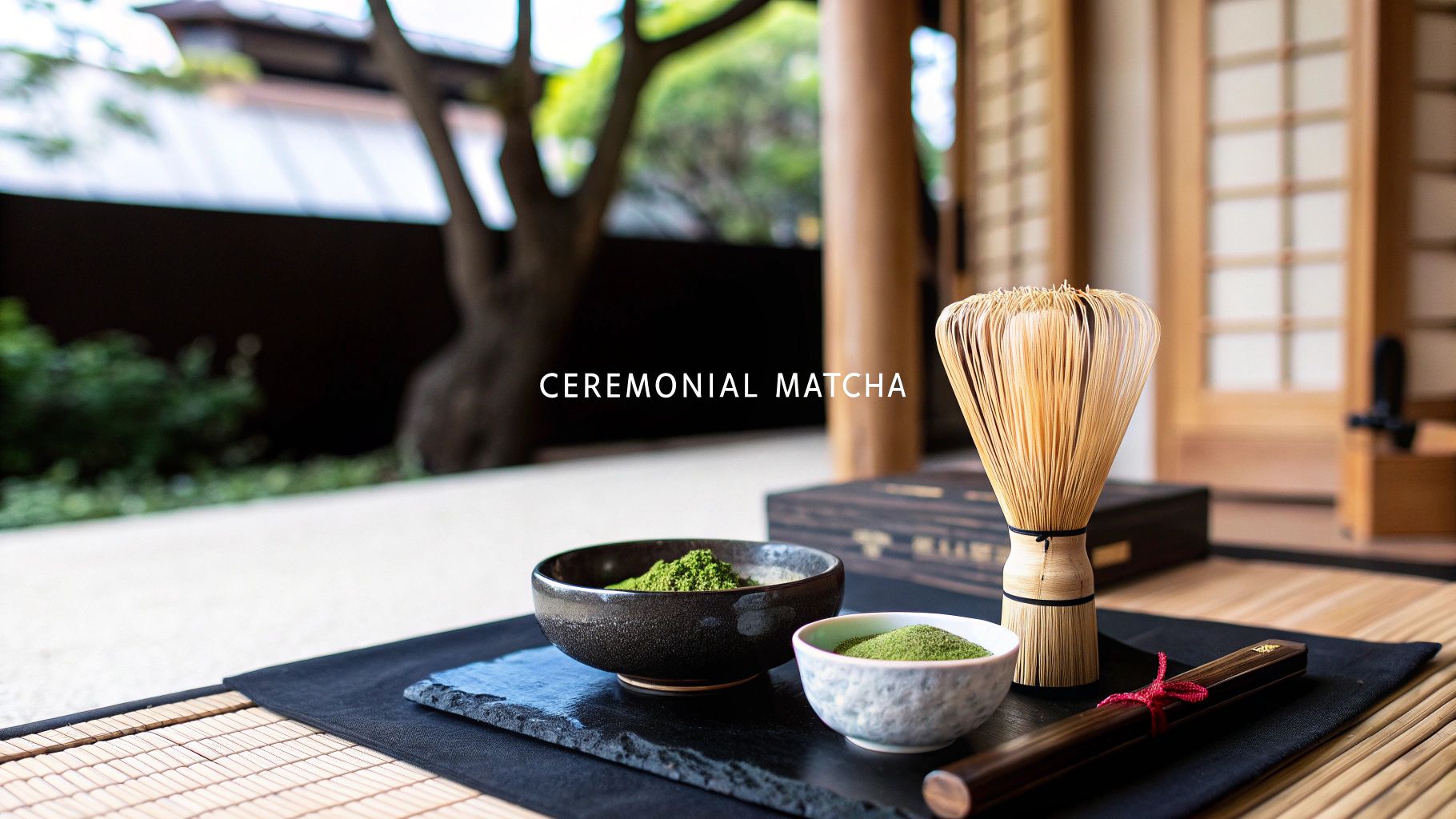
Discover what sets matcha ceremonial grade apart. Learn how it's made, its benefits, and how to prepare the perfect bowl for an authentic experience.
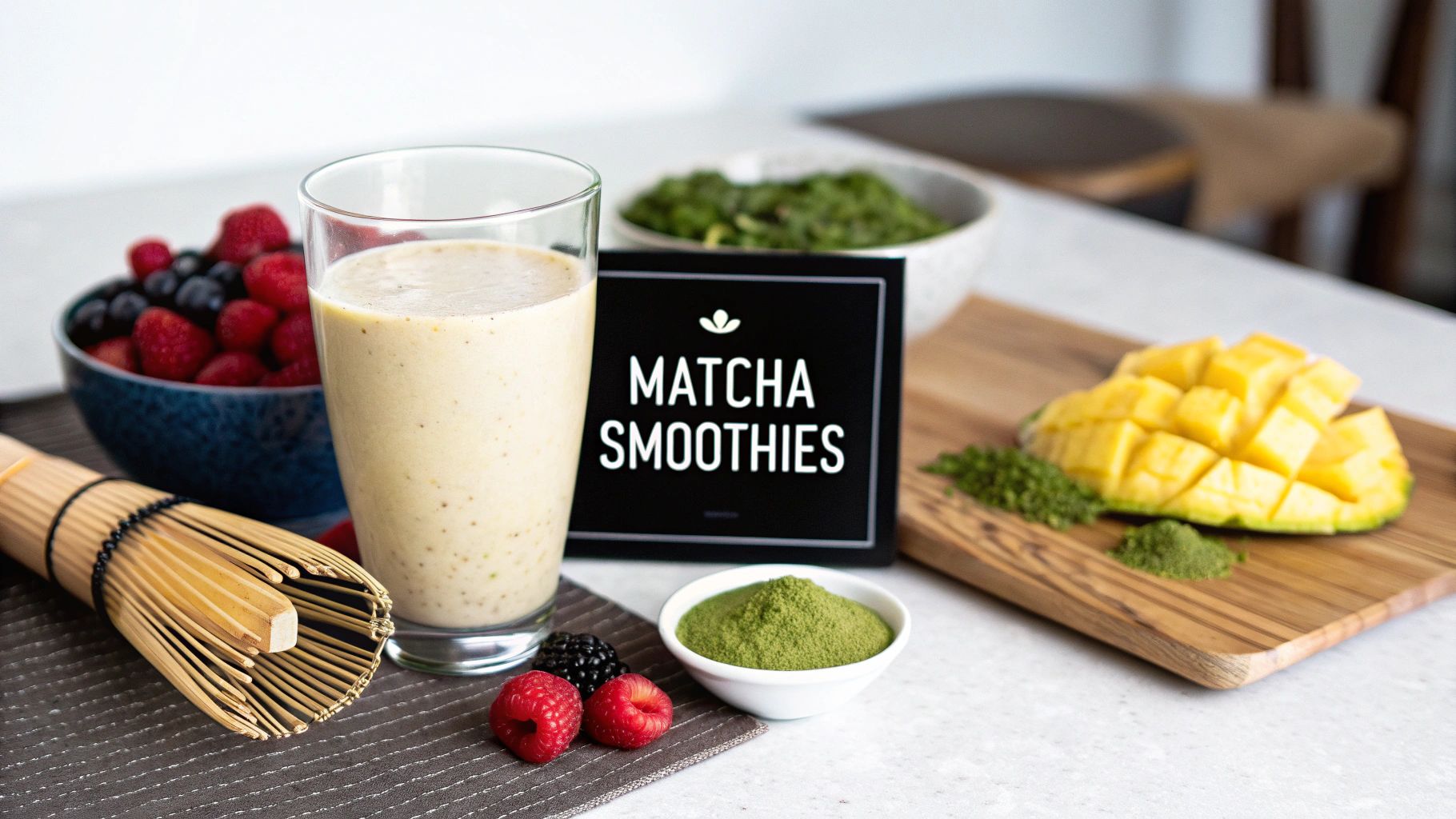
Discover 4 energizing matcha recipes smoothie lovers will adore. Boost your wellness with delicious, easy-to-follow guides using premium Amatsu Matcha.
